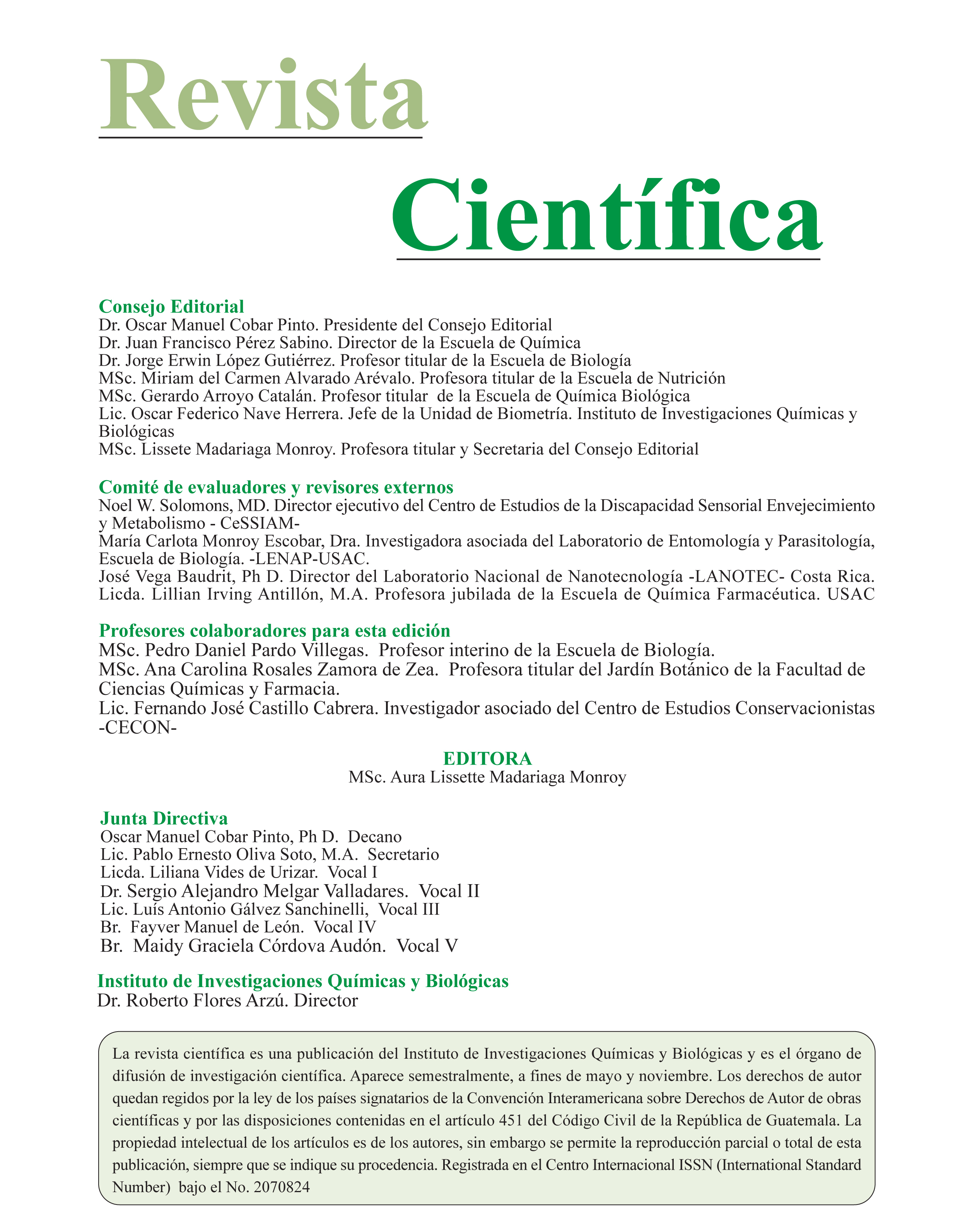Aquatic macroinvertebrates of the lentic bodies of the Maya Region, Guatemala
DOI:
https://doi.org/10.54495/Rev.Cientifica.v23i1.107Keywords:
water quality, bioinbdicators, lentic, community, physicochemicalAbstract
The composition of aquatic macroinvertebrate community has been used to determine the ecological status of lentic ecosystems in many water quality studies. In this study, the community structure of the aquatic macroinvertebrates was surveyed in seven lentic bodies (Yaxhá, Sacnab, Petenchel, Quexil, Salpetén, Macanche y Sacpuy) located in the Mayan region in northern Guatemala. At each sampling site a maximum of six sampling stations were set and macroinvertebrate samples were collected with an Ekman dredge. In addition, measurements of the following physicochemical variables were taken: dissolved oxygen, temperature, pH, salinity, conductivity, total dissolved solids, nutrients, sulfate and depth. A total species richness of 38 taxa was found, Odonata, Coleoptera, Trichoptera and Ephemeroptera were the most diverse orders. Species diversity was high in places where there is no anthropogenic influence and tended to decrease as some human disturbance was observed. The distribution of aquatic macroinvertebrates was influenced by the type of substrate and physicochemical changes.
Downloads
References
Alba-Tercedor, J. (1996). Macroinvertebrados acuáticos y calidad de las aguas de los ríos. IV Simposio del agua en Andalucía (SIAGA), Almeria, España 2: 203-213.
APHA, AWWA & WEF. (2005). Standard methods for the examination of water and wastewater. American Public Health Association. American Water Works Association. Water Environment Federation. EEUU: United Book Press.
Barbour, M.T., Gerritsen, J., Snyder, B.D. & Stribling, J.B. (1999). Rapid bioassessments protocols for use in streams and wadeable rivers: periphyton, benthic macroinvertebrates and fish. EPA 841-B-99-002. EEUU: EPA.
Basterrechea, M. (1988). Limnología del Lago Petén Itzá, Guatemala. Rev. Biol. Trop., 36(1): 123-127.
Brezonik, P. & Fox, J. (1974). The Limnologyof Selected Guatemalan Lakes.Hydrobiologia, 45(4): 467 -487. https://doi.org/10.1007/BF00012032 DOI: https://doi.org/10.1007/BF00012032
Cowell, B.C. & Vodopich, D.S. (1981). Distribution and seasonal abundance of benthic macroinvertebrates in a subtropical Florida lake. Hydrobiologia, 78: 97-105. https://doi.org/10.1007/BF00007582 DOI: https://doi.org/10.1007/BF00007582
Espinoza, N. y Morales, F.E. (2008). Macroinvertebrados bentónicos de la Laguna Las Peonías, estado Zulia, Venezuela. Boletín del Centro de Investigaciones Biológicas, 42(3): 345-363.
Figueroa, R., Valdovinos, C., Araya, E. y Parra, O. (2003). Macroinvertebrados bentónicos como indicadores de calidad de agua de ríos del sur de Chile. Rev. Chil. Hist. Nat., 76: 275-285. https://doi.org/10.4067/S0716-078X2003000200012 DOI: https://doi.org/10.4067/S0716-078X2003000200012
Gotelli N. & Ellison, A. (1960). A primer of Ecological statistics. EEUU: Sinauer Associates.
Heino, J. (2000). Lentic macroinvertebrate assemblage structure along gradients in spatial heterogeneity, habitat size and water chemistry. Hydrobiologia, 418: 229–242. https://doi.org/10.1023/A:1003969217686 DOI: https://doi.org/10.1023/A:1003969217686
McCune, B. & Grace, J. (2002). Analysis of Ecological Communities. EEUU: MjM Software Design.
Merritt, R.W. Cummins, K.W. & Berg, M.B. (2008). An introduction to the aquatic
insects of North America. EEUU: Kendall/Hunt Publishing Company.
Pape, E. (2002). Valor Económico del Lago Petén Itzá: Problemas y oportunidades. Guatemala: Editorial de Ciencias Sociales.
Roldán. G. (1988). Guía para el estudio de los macroinvertebrados acuáticos del Departamento de Antioquia. Colombia: Editorial Presencia.
Roldán, G. y Ramírez, J. (2008). Fundamentos de Limnología Neotropical. Colombia: Editorial Universidad de Antioquia.
Rosenberg, D.M. & Resh, V.H. (eds.). (1993). Freshwater biomonitoring and benthic macroinvertebrates. EEUU: Chapman & Hall.
Sibaja-Cordero, J. y Umaña-Villalobos, G. (2008). Invertebrados bentónicos del Lago Cote, Costa Rica. Rev. Biol. Trop., 56(4): 205-213.
Sponsseller, R.A., Benfield, E.F. & Vallet, H.M. (2001). Relationships between land use, spatial scale and stream macroinvertebrate communities. Freshwater Biol., 46:1409-1424. https://doi.org/10.1046/j.1365-2427.2001.00758.x DOI: https://doi.org/10.1046/j.1365-2427.2001.00758.x
Springer, M., Ramírez, A. & Hanson, P. (eds.). (2010). Macroinvertebrados de agua dulce de Costa Rica I. Rev. Biol. Trop., 58 (4).
Springer, M. (2006). A Taxonomic key to the families of caddisfly larvae (Insecta: Trichoptera) of Costa Rica. Rev. Biol. Trop., 54 (1): 273-286.
Trama, F.A, Rizo, V.F. y Springer, M. (2009). Macroinvertebrados bentónicos del humedal de Palo Verde, Costa Rica. Rev. Biol. Trop. 57(1): 275-284.
Wetzel, R. (2005). Limnology. EEUU: W. B. Saunders Company. https://doi.org/10.1007/s10201-004-0135-4 DOI: https://doi.org/10.1007/s10201-004-0135-4
Williams, D.D. & Feltmate, B.W. (1992). Aquatic insects. Reino Unido: C.A.B. International. Redwood Press.
Wood, P.J., Greenwood, M.T., Barker, S.A. & Gunn, J. (2001). The effects of amenity management for angling on the conservation value of aquatic invertebrate communities in old industrial ponds. Biol. Conserv. 102: 17-29. https://doi.org/10.1016/S0006-3207(01)00087-8 DOI: https://doi.org/10.1016/S0006-3207(01)00087-8
Downloads
Published
How to Cite
Issue
Section
License
Copyright (c) 2013 Fátima Reyes-Morales

This work is licensed under a Creative Commons Attribution 4.0 International License.
Authors who publish with this journal agree to the following terms:
- Authors retain copyright and grant the journal right of first publication with the work simultaneously licensed under a Creative Commons Attribution License 4.0 that allows others to share the work with an acknowledgement of the work's authorship and initial publication in this journal.
- Authors are able to enter into separate, additional contractual arrangements for the non-exclusive distribution of the journal's published version of the work (e.g., post it to an institutional repository or publish it in a book), with an acknowledgement of its initial publication in this journal.
- Authors are permitted and encouraged to post their work online (e.g., in institutional repositories or on their website) prior to and during the submission process, as it can lead to productive exchanges, as well as earlier and greater citation of published work.









